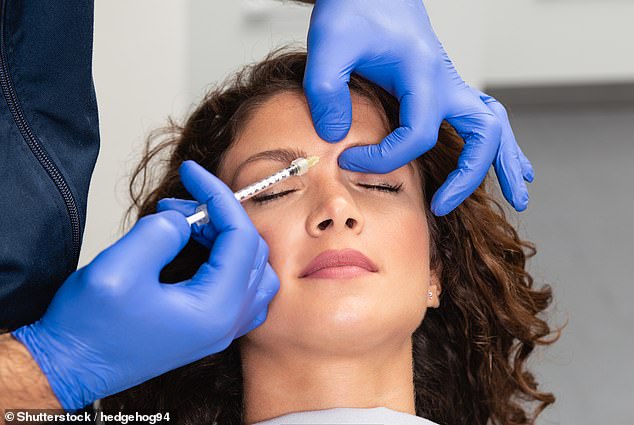You may be guilty of doing this several times a day: hunching over your phone, which puts an incredible amount of strain on your neck.
Many Britons suffering from “tech neck” – caused by bending over to look at devices such as phones or tablets – are turning to Botox for help, doctors have revealed.
The “tech neck” cure, dubbed “traptox” because of the trapezius muscles at the back of the neck that the injections target, will cost people £600.
It works in a similar way to how cosmetic injections act on wrinkles, paralyzing the nerve signals that cause the muscles to contract, relaxing them and, in the case of the neck, improving mobility.
Some London doctors report seeing up to 10 patients a month seeking Traptox to relieve their tech neck pain, with some patients needing repeat injections every six to nine months.
Some London doctors report seeing up to 10 patients a month seeking Traptox to relieve their tech neck pain, with some patients needing repeat injections every six to nine months. File image
Dr. Ashwin Soni, Plastic and Reconstructive Surgeon, said The telegraph The number of patients seeking this treatment was increasing.
“Many of them suffer pain because they constantly bend their neck forward and do not take good care of their posture,” he explained.
‘I’m probably seeing up to 10 patients a month at the moment and most of them are over 40.
‘They may have spent years hunched over their desks or smartphones and not taken good care of their posture.
Dr Soni added that he only offers people “one or two” traptox injections as a “quick fix” before recommending that patients see a professional such as a physical therapist or take up a mobility-enhancing exercise such as yoga or pilates.
This comes after researchers at King’s College London recently presented new evidence of the impact that hunching over technology has on our necks.
Presented at an event at the Royal Society of Medicine’s section on aesthetic medicine and surgery, the study showed that when the human head is in a normal, tense posture, it exerts approximately 5 kg (11 lb) of tension on the spine.
But at the hunched angle of the “tech neck,” the stress level quadruples to 22 kg (48 lb).
Beyond pain, poor neck posture can lead to a host of problems, including tension headaches, muscle spasms, and even the development of painful bony growths called spurs on the joints of the neck.
Although adults glued to their smartphones are thought to be most at risk for technology neck, doctors are concerned that future generations could face even bigger problems.
Previous studies have suggested that children aged between two and 11 use screens for up to 4.5 hours a day, much more than the recommended hour.
According to analysts, children between the ages of two and 11 watch four times the recommended amount (4.5 hours a day) of recorded programming, the Journal reported.
More recent British research has suggested that for young people aged eight to 18 it is about four hours a day, but this figure rises to five in adulthood.
Some doctors have warned that they are seeing an increasing number of cases of children suffering problems due to their use of technology.
These include torticollis (where the neck muscles start to spasm, tilting the head to one side) and general reduced mobility due to being glued to devices.
The World Health Organization recommends that children spend no more than one hour a day in front of screens.

Britons suffering from “tech neck” – caused by hunching over devices such as phones or tablets – are turning to Botox to ease their pain, doctors have revealed. File image

Nearly four in five Britons who receive anti-wrinkle injections suffer adverse side effects, research suggests
Prevention tips for tech neck include limiting screen time and, where not possible due to work or education, ensuring screens are positioned directly at eye level to relieve strain on muscles and joints.
Cosmetic treatments using botulinum toxin (the most widely recognised brand name of which is Botox) are not available on the NHS.
It is available to some patients with certain health conditions who may benefit from Botox’s ability to paralyze certain tissues.
This includes those that cause spasms, migraines, and excessive sweating.
While Botox is generally considered safe, like any medication, there is a risk of side effects that can vary in severity.
Research published last year suggested that almost four in five Britons who receive anti-wrinkle injections suffer such effects, with the most common being headaches, pain, dizziness and brain fog.


